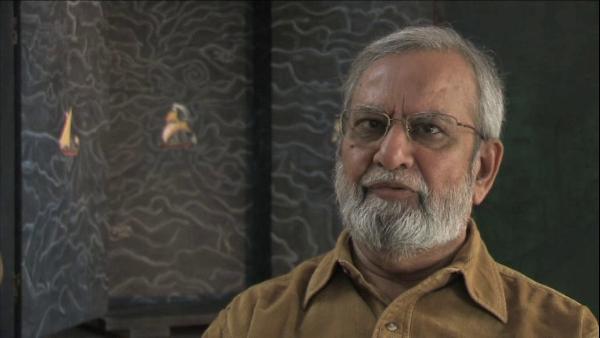NEXT STORY

Going to study at the Royal College of Art in London
RELATED STORIES

NEXT STORY

Going to study at the Royal College of Art in London
RELATED STORIES


|
Views | Duration | |
|---|---|---|---|
| 11. Mohandas Gandhi and writing | 59 | 03:58 | |
| 12. Family and going to Baroda | 60 | 05:39 | |
| 13. Life and people at Baroda | 1 | 75 | 09:20 |
| 14. Meeting other artists and developing my own style | 59 | 04:33 | |
| 15. The art scene in the '60s and my subject matter | 69 | 04:14 | |
| 16. Teaching history of art | 51 | 09:26 | |
| 17. Literary activities (Part 1) | 48 | 06:03 | |
| 18. Literary activities (Part 2) | 37 | 04:16 | |
| 19. Group 1890 and having a show | 116 | 05:53 | |
| 20. Other members of Group 1890 and our beliefs | 87 | 04:04 |


Swami was much older than me. There were many who were older than me. Jyoti Bhatt, Balkrishna Patel, Jeram Patel, majority of them, perhaps, we were 12, all from different parts of India – Reddeppa Naidu from south, Eric Bowen from Delhi, Rajesh Mehra from Delhi, then... so, I think I was among the youngest, one of the youngest. But I had a communication channel with Swaminathan because I had read his articles in, it was a left journal called Link and he used to write a column. He used to write on art, and I was quite sort of attracted to the way he articulated. And he was looking for a new avenue. It’s also interesting that what we spoke about in the catalogue, about, let us say, new art didn’t seem to be visible in the work that we showed at that time but it was something which we dreamt of or we, it was in the offing. As perhaps those who are familiar with art, you know, those years would know that Swaminathan’s work was in that sense, in those days very, I mean, it was something what you call quasi-primitive. You know, he painted bisons, in fact, you know, and that kind of stuff. Very dark colours. But eventually he began to, you know, he moved, he drifted, you know, from that to something, you know, which was very different, almost quasi-metaphysical paintings, you know, with a bird in the air, on a rock and things like that. But, anyway, it was a great moment for all of us, you know, for Indian artists of that generation, even though we were not of the same age, to come together and make a statement. And that eventually took us in kind of an area where we began to sort of open, we opened a kind of a debate on Indian art. Well, the group continued for a while and it, there were efforts made to revive it but it didn’t work. It was that moment and it lived for that moment and then, but what it lived in was another moment, that eventually Swaminathan became more and more engaged in art politics and among things that he seemed to be most attracted to was to sort of enter into the national debate on the role of the state in art. And I think that the debate began with him questioning the role of the Lalit Kala Academy, therefore the national art academy, and he began a journal called Contra, which is a small journal, a few numbers, and after that I got engaged in that debate and we began to publish a journal. We published for 4 years with Bhupen Khakhar called Vrishchik.
Wasn’t that only when you came back from...?
That comes... so, I’m just giving you the link, you know, from that, the politics of art. You know, that continued right up to ’73. So, from beginning, from the, from 1963, when the group exhibition of Group 1890 took place in Delhi to 10 years later.
Gulammohammed Sheikh is an Indian painter, writer and art critic who has been a major figure in the Indian art world for half a century. His artistic career is closely associated with the renowned MS University of Baroda in Gujarat where after gaining his Master's degree, Sheikh went on to teach in the Faculty of Fine Arts, and where he was appointed Professor of Painting in 1982.
Title: Other members of Group 1890 and our beliefs
Listeners: Timothy Hyman
Timothy Hyman is a graduate of Slade School of Fine Art, London, in which he has also taught. In 1980 and 1982, he was Visiting Professor in Baroda, India. Timothy Hyman has curated many significant art exhibitions and has published articles and monographs on both European and Indian artists.
Duration: 4 minutes, 4 seconds
Date story recorded: December 2008
Date story went live: 18 November 2010